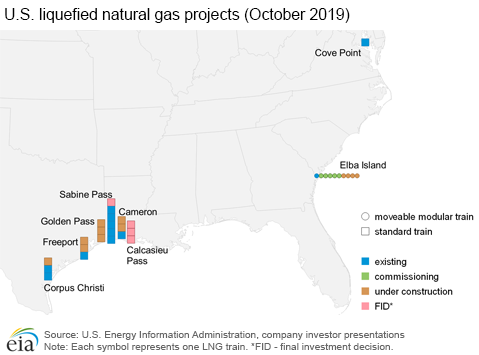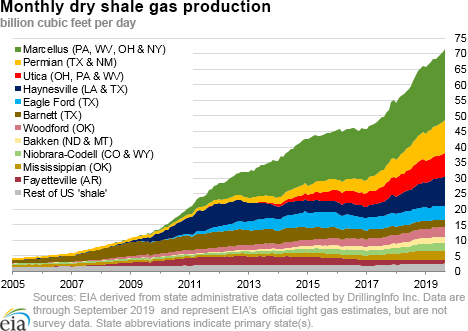In the News:
Elba Island, the sixth U.S. LNG export terminal, begins commercial operations
On September 30, the Federal Energy Regulatory Commission authorized the Elba Liquefaction Company, L.L.C. and Southern LNG Company, L.L.C.―the developers of the Elba Island liquefied natural gas (LNG) export terminal―to place the first of 10 liquefaction units into commercial service. Elba Island LNG became the sixth U.S. LNG liquefaction export facility to begin LNG production in the Lower 48 states since 2016.
Elba Island LNG is the smallest of the U.S. LNG export facilities, with a total capacity of 0.3 billion cubic feet per day (Bcf/d) across 10 portable small-scale units (called trains), each with a capacity of 0.03 Bcf/d. Elba Island uses a new technology called Moveable Modular Liquefaction System (MMLS), which was developed by Royal Dutch Shell. Trains 2 and 3 are in the start-up phase, Trains 4 through 6 are being commissioned, and Trains 7 through 10 are under construction, according to project developers. All trains are scheduled to be commissioned sequentially in one-month intervals.
Elba Island LNG is located near Savannah, Georgia, close to the Georgia-South Carolina border at the site of an existing regasification terminal, which allows the new liquefaction facility to share LNG storage tanks, pipelines, and other infrastructure with the regasification terminal. Elba Island can still import, store, and regasify LNG. The last LNG import cargo was received at Elba Island on October 13, 2019.
The Elba Island terminal is connected to the pipeline network through the Elba Express pipeline, which has interconnections with the Southern Natural Gas Pipeline System (SNG) and Transcontinental Pipeline (TransCo) in Georgia and South Carolina. To accommodate additional southbound flows to the export project, two new compressor stations were installed on the Elba Express pipeline, one in Georgia and one in South Carolina.
Elba Island will operate as a tolling facility where LNG off-takers will pay a liquefaction tolling fee to the project owners. The export capacity of Elba Island is fully contracted by Royal Dutch Shell under a 20-year tolling agreement. Shell is responsible for procuring its own natural gas feedstock for liquefaction and LNG marketing. According to Shell, natural gas liquefied at Elba Island will be exported to the global LNG spot markets.
Elba Island has five LNG storage tanks with a total capacity of 535,000 liquid cubic meters (11.3 billion cubic feet). Given the small size of liquefaction units, if all 10 units were producing LNG at a nameplate liquefaction capacity, it would take about nine days to fill one storage tank (3.0 Bcf capacity), or 35 days to fill all five storage tanks, according to EIA calculations. Typically, one storage tank holds an LNG volume equivalent to a standard-size LNG cargo (about 3 Bcf). The first LNG exports from the facility are expected in the next few months.
Overview:
(For the week ending Wednesday, October 16, 2019)
- Natural gas spot prices rose at most locations this report week (Wednesday, October 9 to Wednesday, October 16). Henry Hub spot prices rose from $2.22 per million British thermal units (MMBtu) last Wednesday to $2.25/MMBtu yesterday.
- At the New York Mercantile Exchange (Nymex), the price of the November 2019 contract increased 7¢, from $2.234/MMBtu last Wednesday to $2.303/MMBtu yesterday. The price of the 12-month strip averaging November 2019 through October 2020 futures contracts climbed 1¢/MMBtu to $2.377/MMBtu.
- Net injections to working gas totaled 104 billion cubic feet (Bcf) for the week ending October 11. Working natural gas stocks are 3,519 Bcf, which is 16% more than the year-ago level and equal to the five-year (2014–18) average for this week.
- The natural gas plant liquids composite price at Mont Belvieu, Texas, rose by 16¢/MMBtu, averaging $5.28/MMBtu for the week ending October 16. The price of ethane fell by 4%. The price of natural gasoline and propane rose by 5%, and the price of butane and isobutane each 4%.
- According to Baker Hughes, for the week ending Tuesday, October 8, the natural gas rig count decreased by 1 to 143. The number of oil-directed rigs rose by 2 to 712. The total rig count increased by 1, and it now stands at 856.
Prices/Supply/Demand:
Prices end the week at highs in most markets. This report week (Wednesday, October 9 to Wednesday, October 16), Henry Hub spot prices rose 3¢ from $2.22/MMBtu last Wednesday to a high of $2.25/MMBtu yesterday. Temperatures were generally cooler than normal across most of the country, putting upward pressure on prices. At the Chicago Citygate, prices increased 37¢ from $1.74/MMBtu last Wednesday to a high of $2.11/MMBtu yesterday.
Northern California prices are flat while Southern California prices decline. Prices at Pacific Gas and Electric (PG&E) Citygate in Northern California were unchanged week over week at $3.25/MMBtu, reaching a low of $3.11/MMBtu on Friday when PG&E shut off electricity to customers in 34 California counties. Prices at the SoCal Citygate decreased 31¢ from $3.58/MMBtu last Wednesday to $3.27/MMBtu yesterday.
Northeast prices rise but remain discounted to the rest of the country. At the Algonquin Citygate, which serves Boston-area consumers, prices went up 27¢ from $1.76/MMBtu last Wednesday to a high of $2.03/MMBtu yesterday. At the Transcontinental Pipeline Zone 6 trading point for New York City, prices increased 47¢ from $1.57/MMBtu last Wednesday to a high of $2.04/MMBtu yesterday.
Tennessee Zone 4 Marcellus spot prices increased 41¢ from $1.46/MMBtu last Wednesday to a high of $1.87/MMBtu yesterday. Prices at Dominion South in southwest Pennsylvania rose 42¢ from $1.40/MMBtu last Wednesday to a high of $1.82/MMBtu yesterday.
Permian Basin prices rise. Prices at the Waha Hub in West Texas, which is located near Permian Basin production activities, averaged $0.92/MMBtu last Wednesday, $1.30/MMBtu lower than Henry Hub prices. Yesterday, prices at the Waha Hub averaged $1.35/MMBtu—the highest of the week―90¢/MMBtu lower than Henry Hub prices.
Supply is flat despite dry natural gas production exceeding 94 Bcf/d. According to data from IHS Markit, the average total supply of natural gas remained the same as in the previous report week, averaging 98.3 Bcf/d. Dry natural gas production grew by 1% compared with the previous report week and exceeded 94 Bcf/d most days in this report week. Average net imports from Canada decreased by 6% from last week.
Demand is down in all sectors. Total U.S. consumption of natural gas fell by 1% compared with the previous report week, according to data from IHS Markit. Natural gas consumed for power generation declined by 7% week over week. Industrial sector consumption decreased by 2% week over week. In the residential and commercial sectors, consumption increased by 22% as heating and cooling demand was moderate with seasonal autumn temperatures. Natural gas exports to Mexico decreased 3%.
U.S. LNG exports decrease over week. Ten LNG vessels (seven from Sabine Pass, two from Corpus Christi, and one from Cameron LNG export terminals) with a combined LNG-carrying capacity of 35 Bcf departed the United States between October 10 and October 16, according to shipping data compiled by Bloomberg. Three vessels were loading on Wednesday (one at each Sabine Pass, Freeport, and Corpus Christi LNG terminals).
Elba Island LNG terminal has imported an LNG cargo on October 13, 2019 likely to be used as a cool down cargo for commissioning of the Elba Island liquefaction units (trains). The cargo was imported from Trinidad & Tobago, according to Bloomberg. The first LNG train at Elba Island began commercial operations at the end of September.
Storage:
Net injections into storage totaled 104 Bcf for the week ending October 11, compared with the five-year (2014–18) average net injections of 81 Bcf and last year's net injections of 82 Bcf during the same week. Working gas stocks totaled 3,519 Bcf, which is 14 Bcf more than the five-year average and 494 Bcf more than last year at this time.
According to The Desk survey of natural gas analysts, estimates of the weekly net change from working natural gas stocks ranged from net injections of 99 Bcf to 115 Bcf, with a median estimate of 107 Bcf.
The average rate of net injections into storage is 27% higher than the five-year average so far in the refill season (April through October). If the rate of injections into storage matched the five-year average of 9.3 Bcf/d for the remainder of the refill season, total inventories would be 3,706 Bcf on October 31, which is 14 Bcf higher than the five-year average of 3,692 Bcf for that time of year.
More storage data and analysis can be found on the Natural Gas Storage Dashboard and the Weekly Natural Gas Storage Report.
See also:
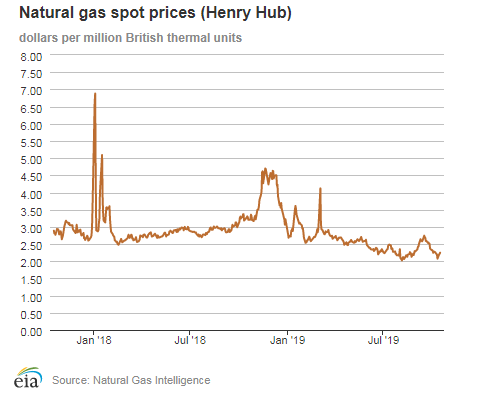
| Spot Prices ($/MMBtu) | Thu, 10-Oct |
Fri, 11-Oct |
Mon, 14-Oct |
Tue, 15-Oct |
Wed, 16-Oct |
|---|---|---|---|---|---|
| Henry Hub |
2.20 |
2.08 |
2.20 |
2.22 |
2.25 |
| New York |
1.46 |
1.11 |
1.61 |
1.75 |
2.04 |
| Chicago |
1.78 |
1.74 |
1.85 |
1.97 |
2.11 |
| Cal. Comp. Avg.* |
2.67 |
2.36 |
2.62 |
2.56 |
2.59 |
| Futures ($/MMBtu) | |||||
| November contract | 2.218 |
2.214 |
2.280 |
2.339 |
2.303 |
| December contract |
2.417 |
2.457 |
2.498 |
2.532 |
2.495 |
| *Avg. of NGI's reported prices for: Malin, PG&E Citygate, and Southern California Border Avg. | |||||
| Source: NGI's Daily Gas Price Index | |||||
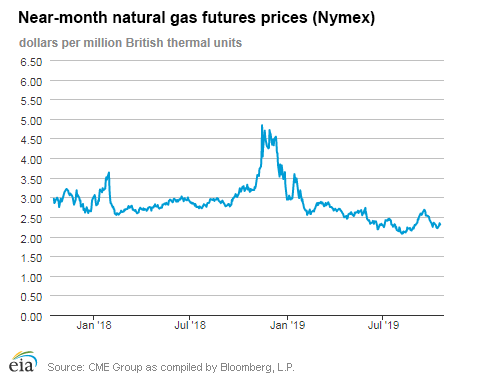

| U.S. natural gas supply - Gas Week: (10/10/19 - 10/16/19) | |||
|---|---|---|---|
Average daily values (Bcf/d): |
|||
this week |
last week |
last year |
|
| Marketed production | 106.3 |
105.6 |
98.0 |
| Dry production | 94.0 |
93.4 |
86.3 |
| Net Canada imports | 4.2 |
4.5 |
4.7 |
| LNG pipeline deliveries | 0.1 |
0.1 |
0.1 |
| Total supply | 98.3 |
97.9 |
91.0 |
|
Source: IHS Markit | |||
| U.S. natural gas consumption - Gas Week: (10/10/19 - 10/16/19) | |||
|---|---|---|---|
Average daily values (Bcf/d): |
|||
this week |
last week |
last year |
|
| U.S. consumption | 63.3 |
63.6 |
65.3 |
| Power | 30.0 |
32.3 |
29.2 |
| Industrial | 20.6 |
21.0 |
20.4 |
| Residential/commercial | 12.6 |
10.3 |
15.7 |
| Mexico exports | 5.3 |
5.5 |
4.8 |
| Pipeline fuel use/losses | 6.4 |
6.3 |
6.0 |
| LNG pipeline receipts | 6.6 |
6.1 |
2.8 |
| Total demand | 81.5 |
81.5 |
79.0 |
|
Source: IHS Markit | |||
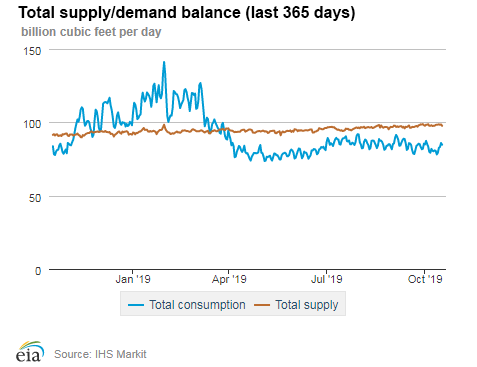
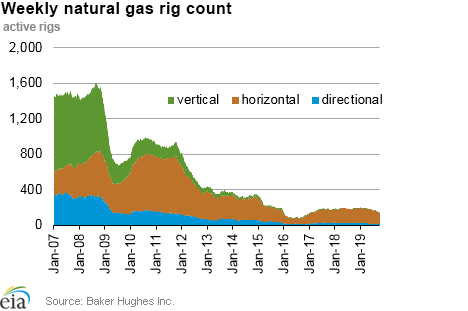
| Rigs | |||
|---|---|---|---|
Tue, October 08, 2019 |
Change from |
||
last week |
last year |
||
| Oil rigs | 712 |
0.3% |
-18.1% |
| Natural gas rigs | 143 |
-0.7% |
-25.9% |
| Note: Excludes any miscellaneous rigs | |||
| Rig numbers by type | |||
|---|---|---|---|
Tue, October 08, 2019 |
Change from |
||
last week |
last year |
||
| Vertical | 51 |
-1.9% |
-22.7% |
| Horizontal | 750 |
0.1% |
-19.1% |
| Directional | 55 |
1.9% |
-21.4% |
| Source: Baker Hughes Inc. | |||
| Working gas in underground storage | ||||
|---|---|---|---|---|
Stocks billion cubic feet (Bcf) |
||||
| Region | 2019-10-11 |
2019-10-04 |
change |
|
| East | 880 |
854 |
26 |
|
| Midwest | 1,044 |
1,009 |
35 |
|
| Mountain | 205 |
203 |
2 |
|
| Pacific | 296 |
296 |
0 |
|
| South Central | 1,093 |
1,054 |
39 |
|
| Total | 3,519 |
3,415 |
104 |
|
|
Source: Form EIA-912, Weekly Underground Natural Gas Storage Report | ||||
| Working gas in underground storage | |||||
|---|---|---|---|---|---|
Historical comparisons |
|||||
Year ago (10/11/18) |
5-year average (2014-2018) |
||||
| Region | Stocks (Bcf) |
% change |
Stocks (Bcf) |
% change |
|
| East | 809 |
8.8 |
871 |
1.0 |
|
| Midwest | 903 |
15.6 |
1,007 |
3.7 |
|
| Mountain | 177 |
15.8 |
207 |
-1.0 |
|
| Pacific | 264 |
12.1 |
320 |
-7.5 |
|
| South Central | 874 |
25.1 |
1,101 |
-0.7 |
|
| Total | 3,025 |
16.3 |
3,505 |
0.4 |
|
| Source: Form EIA-912, Weekly Underground Natural Gas Storage Report | |||||
| Temperature – heating & cooling degree days (week ending Oct 10) | ||||||||
|---|---|---|---|---|---|---|---|---|
HDD deviation from: |
CDD deviation from: |
|||||||
| Region | HDD Current |
normal |
last year |
CDD Current |
normal |
last year |
||
| New England | 79 |
-2 |
49 |
0 |
0 |
-8 |
||
| Middle Atlantic | 58 |
-12 |
48 |
0 |
-2 |
-21 |
||
| E N Central | 57 |
-15 |
37 |
0 |
-3 |
-29 |
||
| W N Central | 67 |
-2 |
-22 |
0 |
-5 |
-7 |
||
| South Atlantic | 12 |
-22 |
12 |
53 |
18 |
-32 |
||
| E S Central | 8 |
-25 |
8 |
42 |
22 |
-41 |
||
| W S Central | 4 |
-5 |
2 |
73 |
31 |
-11 |
||
| Mountain | 82 |
12 |
-18 |
18 |
-1 |
9 |
||
| Pacific | 22 |
-2 |
-3 |
9 |
-4 |
9 |
||
| United States | 42 |
-9 |
16 |
23 |
6 |
-16 |
||
|
Note: HDD = heating degree day; CDD = cooling degree day Source: National Oceanic and Atmospheric Administration | ||||||||
Average temperature (°F)
7-day mean ending Oct 10, 2019
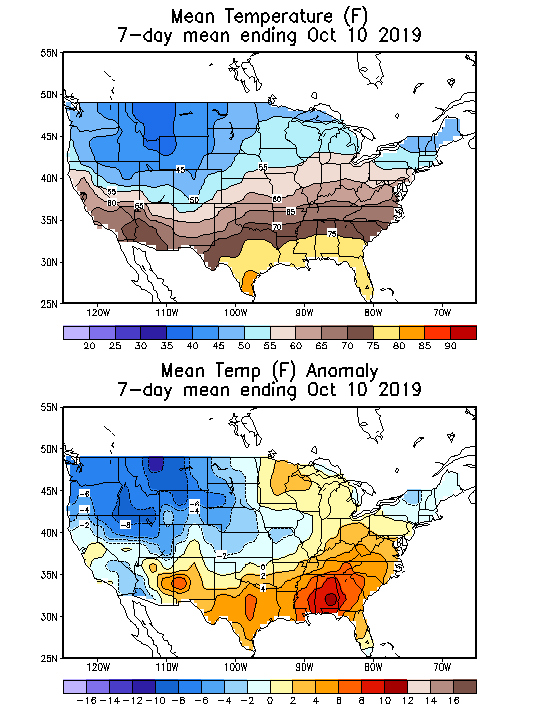
Source: National Oceanic and Atmospheric Administration
Deviation between average and normal (°F)
7-day mean ending Oct 10, 2019

Source: National Oceanic and Atmospheric Administration

